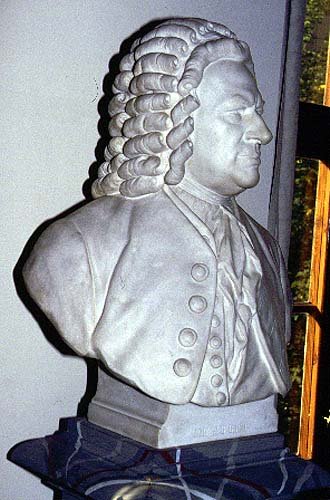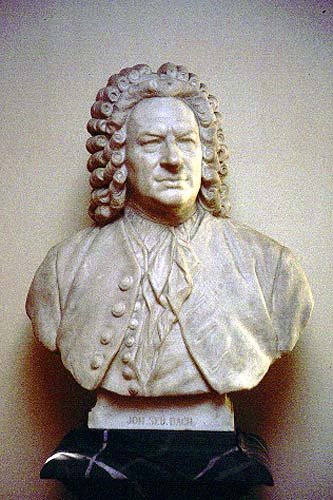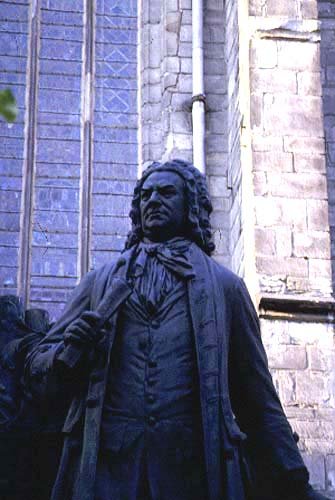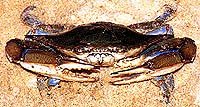The Portraits of Sebastian Bach
I am going to begin this survey of the portraits of Johann Sebastian Bach, authentic
and inauthentic, with an image that is not often seen. It is an early 19th century print
that is based on the famous 1746 Haussmann portrait; this version of the print
appeared as the frontispiece of C. F. Abdy-Williams's 1900 monograph on the
composer.

The print is based on the earlier of two versions that Haussmann painted. That
original, which for many years hung in the Thomasschule in Leipzig, has not fared
well over the years, and it has been heavily restored. Here is a black and white
photograph of that 1746 portrait, which now hangs in the Altes Rathaus in Leipzig,
taken before the most recent of the many attempts that have been made to restore it.

The second version of the painting, which almost certainly is the one that belonged to
Bach's second son, Carl Philipp Emanuel Bach, has fared much, much better. Were
it not for the craquelure, it would seem to have been painted last month, it is so well
preserved! For nearly 50 years it has been in the collection of William H. Scheide, the
founder and first director of The Bach Aria Group. Because it has been reproduced
frequently, it is now perhaps the likeness of the composer that is best known to the
general public. Here is a close-up of the face:

The 1748 Haussmann portrait is the best preserved of the two versions of the only
likeness of Sebastian Bach that is unquestionably authentic. As such, it has to be the
standard against which all of the others are judged.
Among the most convincing of the others is the so-called "Volbach" portrait, named
after the distinguished musicologist and conductor who discovered it in an antique
shop nearly 100 years ago, and to whose son it still belonged in the late 1960s.
(Where it is today, I do not know.) It survived World War II because it had been
locked away for safekeeping in a subterranean bank vault. Although a number of
cogent arguments have been advanced against the authenticity of this remarkable
image, one can easily consider it authentic, a powerful depiction of the composer in
the last months of his life, worn down by years of battling with his superiors and
aged by the stress of his cataract operation at the hands of the opthalmological
pioneer, the Chevalier Taylor.
![Loading 78K - The "Volbach Portrait of J. S. Bach [?]](Pic-TNT/volbach2.jpg)
Another compelling, but definitely posthumous, image is the sculpture that Wilhelm
His carved in 1895, based on the reconstruction of the composer's head that he built
up on a cast of the composer's then recently exhumed skull, using the most recent
pathological and medical information about skin and muscle thickness, and taking the
1746 Haussmann portrait as a guide.


His also used this sculpture as the model for the life-sized statue of Sebastian Bach
that stands in the Thomaskirchof in Leipzig, next to the Thomaskirche, and in front
of the site of the Thomasschule, in which Bach lived and fulfilled many of his
professional duties in the last 27 years of his life.

As powerful and as accurate as the facial features seem, the statue itself seems a trifle
"Romantic" for modern eyes and psyches, but, like many other even more
romanticized images from the same period, it reflects a then standard portrayal of
Bach, the man, as both an individual and as a figure within his time that later research
has shown to be less than accurate. Nonetheless, for many, even now, that is the
image of Bach that is most familiar.
The 1748 Haussmann portrait may be the best known today, but, even 40 years ago,
most people saw Bach through the eyes of Louis Lupas, who based his famous
pastel, still widely circulated on calendars and as an inexpensive print, on this late
19th century engraving.

The "boom" in images of Johann Sebastian Bach is not restricted to posthumous,
romanticized "interpretations". Over the years, a number of portraits have surfaced
that have been put forth as being "lost" images of the composer. Some of these have
a better pedigree than others.
The earliest of these is a portrait that is ascribed to Johann Ernst Rentsch; it is alleged
that this portrait, which has also been heavily restored, depicts Bach during his years
as a member of the ducal musical establishment in Weimar.

There is no independent evidence other than a perceived physical similarity to
confirm that the portrait in fact depicts Sebastian Bach, but it does, nevertheless, give
a good idea of what he might have looked like in his 20s.
To be continued....
Please click on  to return to the Johann Sebastian Bach Index Page.
to return to the Johann Sebastian Bach Index Page.
Please click on the  to return to the Teri Noel Towe
Welcome Page.
to return to the Teri Noel Towe
Welcome Page.
teritowe@alumni.Princeton.EDU
Copyright, Teri Noel Towe, 1997
All Rights Reserved